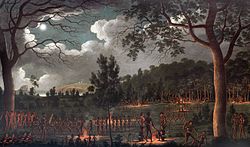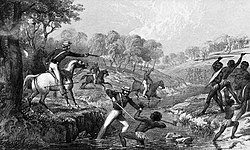Indigenous people resisted British settlement, both physically and psychologically.
Aboriginal resistance to British occupation was immediate. Pemulwuy led counter-raids against settlers and ambushed exploration and foraging parties between 1790 and 1802. There seems to have been little understanding, or perhaps little acknowledgement, on the part of the British as to why Indigenous people in the area acted violently against them.

Corroboree at Newcastle by convict artist Joseph Lycett, ca. 1818. Aboriginal Australian religious practices associated with the Dreamtime have been practised for tens of thousands of years.
There are repeated incidences of lone, or pairs of, stockmen, and individual families in remote areas being killed by Indigenous people. European responses were generally not focussed on finding the individuals responsible but were often indiscriminate and excessive.
Typical of the response of colonial officials was the public order of Governor Grose in February 1796, in response to Aboriginal resistance against white settlement on the Hawkesbury River. The “frequent attacks and depredations” against the people settled on the Hawkesbury, called for them to “mutually… afford each other their assistance” whenever Aboriginal people were “lurking about their grounds” (Collins, 1798, p.458). So non-Indigenous people in these government documents were encouraged to retaliate, they were not to kill indiscriminately or “wantonly” in the words of the time, but they were to subdue Aboriginal people who were fighting for their country.
It is important, however, to think of resistance as not just violent responses to colonisation and dispossession, but as something more complex, involving intense and sustained psychological resistance too. Henry Reynolds explains:
| “
|
While conflict was ubiquitous in traditional societies territorial conquest was virtually unknown. Alienation of land was not only unthinkable, it was literally impossible… [People] certainly did not believe that their land had suddenly ceased to belong to them and they to their land. The mere presence of Europeans, no matter how threatening, could not uproot certainties so deeply implanted in Aboriginal custom and consciousness. The black owners may have been pushed aside but many refused to accept that they had been dispossessed (Reynolds, 1982, p.65).
|
”
|
Reynolds here suggests that resistance was psychological, as well as physical; it was not just about fighting but it was also shown through the refusal of Aboriginal people to give up beliefs, the continued will to survive despite dispossession, to maintain connections to land and to culture and communities.

Mounted police engaging Indigenous Australians during the Slaughterhouse Creek Massacre of 1838
Conflicts and Massacres
Violent confrontations were a feature of the ‘frontier’ as it moved across the continent. In Tasmania, the ‘Black War’ continued for over a decade and martial law was declared from 1828-1832 (Ryan, 2012). Guerrilla resistance continued into the 1890s, most notably by the Kalkadoon warriors of north-central Queensland and the Bunuba people, led by Jandamarra’s warriors, in the Kimberley region in north-west Australia (Lowe, 1994).
Myall Creek Massacre
One of most well-known massacres of the frontier period is the took place at Myall Creek in near Moree in NSW on 10 June 1838. Unlike many other similar events, this is well documented. Around thirty Wirrayaraay people, mainly women, children and older men, who were camping peacefully at the Myall Creek station were rounded up by 11 white stockmen and killed. Even more unusually, the stockmen who perpetrated the killing were put on trial for their actions. Seven were found guilty and hanged.

Windradyne, Aust. Aboriginal warrior from the Wiradjuri
Case study – Windradyne
Windradyne (also known as Saturday) was a Wiradjuri man who lived in the Bathurst region and was known to British authorities for leading guerrilla actions between 1823 and possibly as late as 1828. Thinking also about the first reading by Peter Read, consider the following.
Watch Episode 1 “They Have Come to Stay” from The First Australians. The episode goes for 70 minutes (but well worth watching!)
The chapter below looks at several topics, placing Windradyne and other Indigenous leaders in the context of the society of their time, and considering how knowledge is evaluated in historical analysis:
Foley, D. (2007). Leadership: The Quandary of Aboriginal Societies in Crises, 1788-1830, and 1966. In MacFarlane, I., & Marks, H. (eds). Trangressions: Critical Australian Indigenous Histories (pp. 177-192). Canberra: ANU ePress.
Consider some of the different accounts of relations between Aboriginal peoples and the new settlers in Australia in the Required Readings and Viewings for this week. How much of this history were you already aware of?
Write a short (3-5 sentence) paragraph about what struck you most from the reading.
Key Idea
Indigenous people resisted British settlement, both physically and psychologically.
Aboriginal resistance to British occupation was immediate. Pemulwuy led counter-raids against settlers and ambushed exploration and foraging parties between 1790 and 1802. There seems to have been little understanding, or perhaps little acknowledgement, on the part of the British as to why Indigenous people in the area acted violently against them.
There are repeated incidences of lone, or pairs of, stockmen, and individual families in remote areas being killed by Indigenous people. European responses were generally not focussed on finding the individuals responsible but were often indiscriminate and excessive.
Typical of the response of colonial officials was the public order of Governor Grose in February 1796, in response to Aboriginal resistance against white settlement on the Hawkesbury River. The “frequent attacks and depredations” against the people settled on the Hawkesbury, called for them to “mutually… afford each other their assistance” whenever Aboriginal people were “lurking about their grounds” (Collins, 1798, p.458). So non-Indigenous people in these government documents were encouraged to retaliate, they were not to kill indiscriminately or “wantonly” in the words of the time, but they were to subdue Aboriginal people who were fighting for their country.
It is important, however, to think of resistance as not just violent responses to colonisation and dispossession, but as something more complex, involving intense and sustained psychological resistance too. Henry Reynolds explains:
Reynolds here suggests that resistance was psychological, as well as physical; it was not just about fighting but it was also shown through the refusal of Aboriginal people to give up beliefs, the continued will to survive despite dispossession, to maintain connections to land and to culture and communities.
Conflicts and Massacres
Violent confrontations were a feature of the ‘frontier’ as it moved across the continent. In Tasmania, the ‘Black War’ continued for over a decade and martial law was declared from 1828-1832 (Ryan, 2012). Guerrilla resistance continued into the 1890s, most notably by the Kalkadoon warriors of north-central Queensland and the Bunuba people, led by Jandamarra’s warriors, in the Kimberley region in north-west Australia (Lowe, 1994).
Myall Creek Massacre
One of most well-known massacres of the frontier period is the took place at Myall Creek in near Moree in NSW on 10 June 1838. Unlike many other similar events, this is well documented. Around thirty Wirrayaraay people, mainly women, children and older men, who were camping peacefully at the Myall Creek station were rounded up by 11 white stockmen and killed. Even more unusually, the stockmen who perpetrated the killing were put on trial for their actions. Seven were found guilty and hanged.
Required Reading
Ryan, L. (2010). ‘Hard evidence’: the debate about massacre in the Black War in Tasmania. In F. Peters-Little, A. Curthoys, & J. Docker (Eds.), Passionate Histories: Myth, memory and Indigenous Australia (pp. 39–50).
Case study – Windradyne
Windradyne (also known as Saturday) was a Wiradjuri man who lived in the Bathurst region and was known to British authorities for leading guerrilla actions between 1823 and possibly as late as 1828. Thinking also about the first reading by Peter Read, consider the following.
Watch Episode 1 “They Have Come to Stay” from The First Australians. The episode goes for 70 minutes (but well worth watching!)
The chapter below looks at several topics, placing Windradyne and other Indigenous leaders in the context of the society of their time, and considering how knowledge is evaluated in historical analysis:
Foley, D. (2007). Leadership: The Quandary of Aboriginal Societies in Crises, 1788-1830, and 1966. In MacFarlane, I., & Marks, H. (eds). Trangressions: Critical Australian Indigenous Histories (pp. 177-192). Canberra: ANU ePress.
Learning Activity
Consider some of the different accounts of relations between Aboriginal peoples and the new settlers in Australia in the Required Readings and Viewings for this week. How much of this history were you already aware of?
Write a short (3-5 sentence) paragraph about what struck you most from the reading.
Content is available under the
Creative Commons Attribution Share Alike License.
Privacy Policy | Authors